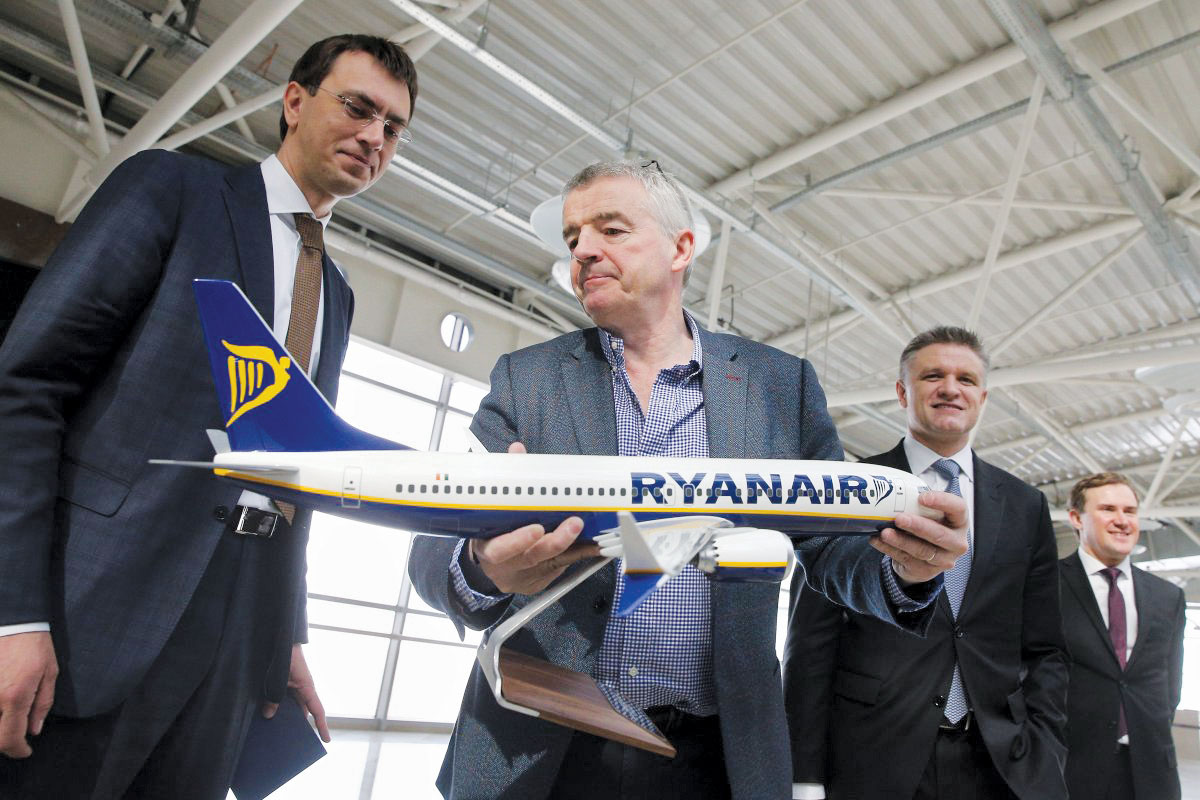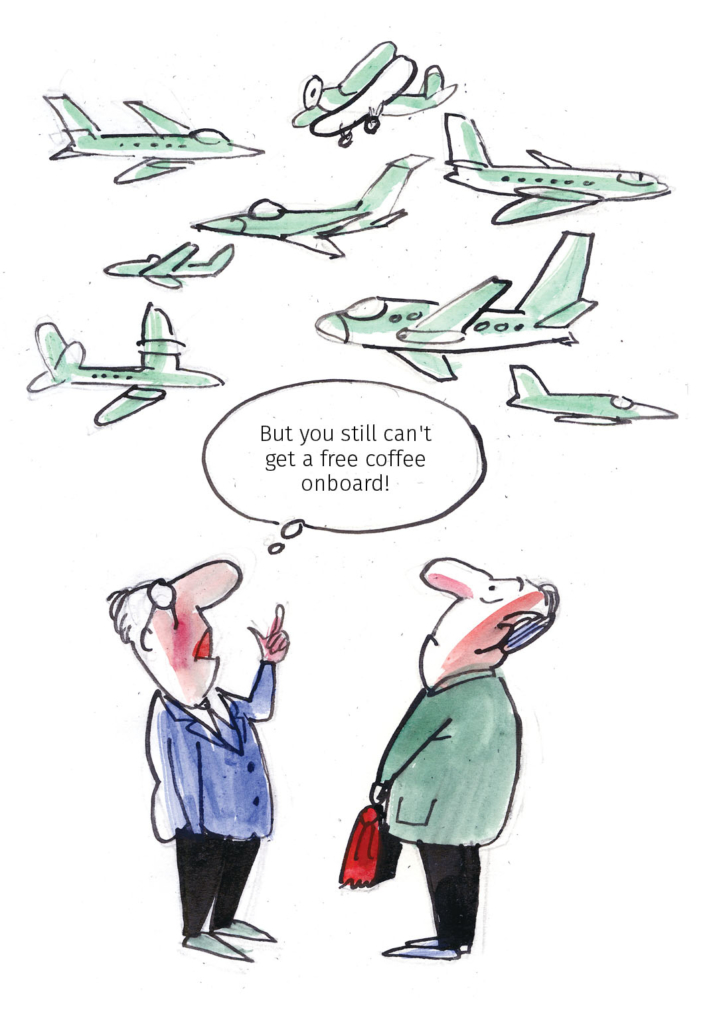Ukraine may finally be entering a golden age of aviation. The economy has shown steady recovery. The Ukrainian passport has more power, allowing its holders to travel freely to 118 countries, including to most in the 28-nation European Union.
Official figures show that stopovers in Ukraine are also on the rise. Passenger traffic through Ukrainian airports grew by 27 percent to 16.5 million people last year, with most of them being transfer passengers.
With all of that, Ukraine is striving for more air connectivity and affordable airfares, but the market has long been dominated by the flagship Ukraine International Airlines. But now the leader is facing competition from European low-cost carriers, lured by attractive conditions bestowed by the Ukrainian government.
Ryanair is back
The Ukrainian government has won back Europe’s largest low-cost airline Ryanair. A second attempt ended with successful negotiations last week between the airline and Kyiv’s Boryspil International Airport. The carrier plans to fly to Ukraine starting in mid-October.
Ryanair won’t be the first or even the best European low-coster in Ukraine. The Irish company has been notorious for poor treatment of pilots and crew, as well as poor customer service.
But the Ukrainian government viewed it as an important step towards European integration that would bring not only more visitors to the country, but make it attractive to big foreign firms.
The first attempt at entry into the market came after Ukraine won visa-free travel within Europe’s Schengen area starting June 2017. But in July, the company canceled its plans after Kyiv’s Boryspil airport refused to meet its conditions.
Many believed that the airport’s main client, Ukraine International Airlines, blocked the deal to protect its interests. Among them was Infrastructure Minister Volodymyr Omelyan, who accused UIA of “trying to retain its monopoly on the market” by fending off low-cost competitors.
UIA called accusations of monopoly a myth and filed lawsuits against the ministry and Lviv airport, which had agreed to Ryanair’s conditions, terms that UIA considered discriminatory.

Ryanair CEO Michael O’Leary and Ukraine’s Minister of Infrastructure Volodymyr Omelyan speak at a press briefing on March 23, 2018 at Kyiv’s Boryspil International airport marking the launch of Ryanair’s flights to Ukraine. (source)
Discounts from the airport
The terms of the deal between Kyiv’s Boryspil airport and Ryanair have not been fully disclosed to the public. It is known that the Irish carrier received lower airport fees, promising to bring at least 800,000 passengers annually to Ukraine.
As of February 2018, Boryspil airport changed its discount policy on airport fees. Now airlines are eligible for 20 percent to 80 percent discounts based on new flights they launch and, most importantly, the number of passengers they bring on existing regular flights.
Oleg Bondar, managing partner at ECOVIS Bondar & Bondar law firm, UIA’s legal advisor, reckons that the main beneficiary of the new pricing order will be Ryanair. In an op-ed on Liga.net, he called the traffic-pegged discounts an unfair preference to any foreign airline whose business model is built on stealing passengers from other airlines instead of opening new routes.
“UIA isn’t against Ryanair. But we think it’s wrong when an airline that promises 200,000 passengers gets lower tariffs from an airport than a national carrier that brings several million people and more profits to the airport,” he said in an interview with the Kyiv Post on March 12. “This distorts competition.”
Boryspil’s director Pavlo Ryabikin in a February interview with RBC said the management had foreseen the risks and introduced the term “cannibalized passengers” to identify those travelers who moved from one airline to another.
“Our goal is to stimulate traffic growth, not its migration,” Ryabikin said. “That’s why instead of incentivizing new flights, we offer the wider idea of incentivizing growth.”
He said that if existing carriers begin to lose passengers after a new carrier enters the market, it is considered “cannibalization,” and the newcomer won’t get any discounts on airport fees.
Fair competition on the ground
While one dominant, state-owned airline is a common phenomenon in many countries, UIA isn’t your typical national carrier. It is a private company co-owned by billionaire oligarch Igor Kolomoisky, who also controls charter flights leader Wind Rose.
The closest thing UIA ever had to a competitor was Aerosvit, a private airline owned by Kolomoisky. In 2010, UIA was privatized by Kolomoisky’s group and soon inherited Aerosvit’s fleet and flights after it went bankrupt. Similarly, Wind Rose took over Dniproavia, another small airline from Kolomoisky’s group.
There’s nothing necessarily wrong about a monopoly, especially in the aviation sector, which is strictly regulated by air travel agreements. Conditions vary from country to country. There are many, like Poland or Georgia, that have “open skies” agreements with Ukraine, meaning an unlimited number of airlines can fly to any destination as often as they want. Others, like France, allow only one carrier from Ukraine.
Lawyers attribute the high cost of air travel in Ukraine in general to airport infrastructure, aero navigation, ground handling and air fuel, where competition is light or absent altogether.

Low-cost airlines are increasingly common in the Ukrainian market, with Hungary’s Wizz Air, Italy’s Ernest and Azerbaijan’s Buta Airways already having landed here, and Ireland’s Ryanair on approach.
Oleksandr Aleksyeyenko, partner at the Marchenko Danevych law firm, says that “in Ukraine, airports are monopolies. Generally, they are state-owned and have their service providers. So airlines have to make arrangements with airports and find a compromise on conditions,” he told the Kyiv Post.
Bondar agreed that the government as an owner of airports and Ukraerorukh, a state air navigation service provider, has to lower fees so that airlines can lower air fares.
But for UIA to claim that the Boryspil airport grants unfair preferences to foreign airlines is disingenuous, as it enjoys privileges itself.
According to Aleksyeyenko, the Anti-Monopoly Committee of Ukraine has tightened its control over airports. In 2017, the agency found that Boryspil airport gave “questionable and non-transparent” discounts on airport fees to UIA. The AMCU also fined the Boryspil airport Hr 12.7 million ($486,162) for abusing its natural monopoly by overcharging some airlines for using its infrastructure and unjustifiably refusing access to ground handling services.
Boryspil’s director Ryabikin denied accusations of favoritism to UIA, but called the airline an important strategic partner that generates 60 percent of airport passenger traffic. In 2017, the airport served an all-time record of over 10 million people.
UIA also owns Interavia, the main ground handling service provider at the airport, and holds a 10-year lease on the only hangar in Kyiv where technical maintenance of aircraft can be carried out. It is a major taxpayer and has the largest fleet – 43 aircraft with its latest purchases of a new Boeing 777–200 ER and a Boeing 737–800 NG.
After the Ryanair deal fell through in mid‑2017, Ryabikin came under pressure. If nothing goes wrong, real competition will soon ramp up on several popular routes to Europe.
On 10 flights from Kyiv to five Polish cities, Barcelona, London, Stockholm, Bratislava and Vilnius, Ryanair will mainly compete with UIA and Hungarian low-cost Wizz Air, which flies from Kyiv’s Zhulyany International Airport (recently renamed Sikorskiy International) as well as Wind Rose, Poland’s LOT and British Airways.
